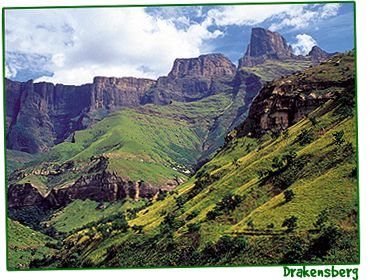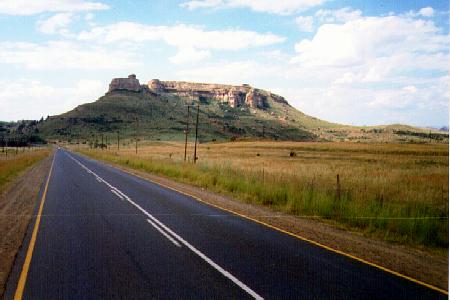|
Tourism:

Drakensberg
©2002: Tourist Office
|

Kogmanskloof
©2002: Tourist Office
|

Natal
©2002: Tourist Office
|

©2002: Tourist Office
|
South Africa has staggeringly beautiful rural areas such as the Cape Winelands, the towering dunes of the Wild Coast,
the magnificent game parks of Kruger and Zululand, and the Kalahari and Karoo Deserts, barren for much of the year but
a carpet of flowers in spring, the possibilities for tourists are endless. South Africa has some of the best, least
crowded surfing in the world; Jeffreys Bay. Cape Town or Kaapstad is one of the most beautiful cities in the world.
It’s dominated by a 1000m-high, flat-topped mountain with virtually sheer cliffs, and surrounded by mountain walks,
vineyards and beaches. Also visit other sophisticated cities such as Pretoria, Durban and Cape Town, or charming
historic towns like Stellenbosch or Pietermaritzburg. Even once infamous townships such as Soweto are now growing
into vibrant cities in their own right. The winelands region around Stellenbosch, sometimes known as the Boland, is
the oldest (18th century) and most beautiful wine-growing region in South Africa. Karoo is for some a boring bit
between Johannesburg and Cape Town but for others one of the most exhilarating regions of South Africa, with unlimited
space and strange mountain ranges. In Kimberly (the diamond region) is the largest hand-made hole in the world.
Sun City in the North-West Province is an extraordinary creation, based on gambling and mildly risqué shows, plus
excellent golf courses, swimming pools, sport facilities, restaurants.
Economy:
Covering a huge swathe of land, washed by the Atlantic and Indian Oceans, South Africa has
enormous wealth above and below ground, making it one of the richest natural storehouses on the planet. South Africa’s
abundant mineral and energy resources form the core of the country’s economic activity. Much of manufacturing is based
on mining, and exports are led by gold and diamonds. The mining industry is amongst the richest in the world, mining
54% of the world’s production of gold, as well as manganese, uranium, diamonds, coal and iron. South Africa is a great
agricultural power. In spite of the fact that only 10% of the land area is cultivated, advanced farming techniques,
irrigation and modern machinery have given it high yeilds. Products for export include maize, wool, sugar, meat, fish,
fruit, and wine. Economic growth remains slow and employment remains stagnant. In the post-apartheid era, the government
has focused on controlling the deficit while striving to step up spending on social programs to combat inequality. The
central bank has used tight macro-economic policies to control inflation. While South Africa’s per capita income of
about $5,030 places it among the middle-income countries, its income disparities are among the most extreme in the world.
Thirteen per cent of the population lives in "first world" conditions. At the other extreme, 53 percent of the population,
live in "third world" conditions. In this group only one quarter of households have access to electricity and running
water; only half have a primary school education; and over a third of the children suffer from chronic malnutrition.
Reducing inequality and poverty, and tackling unemployment, among the highest in the world, are some of the key challenges
faced by the post-apartheid government.
History: Click here for full history
The history of South Africa has brought diverse groups of people to settle this southern-most tip of the African continent.
The earliest arrivals were the San and Khoikhoi people, followed by Bantu peoples. The first white settlement was
established by the Dutch in the Cape in 1652. British settlement and annexation of the Cape Colony followed in the
19th century. This served to forge strong ties among earlier white settlers, who were known as Afrikaners or Boers.
They responded to English domination by turning their ox-wagons north in a movement referred to as the Great Trek.
This led to battles between Afrikaners and Bantu groups, particularly the Zulus, and led to the formation of two Boer
republics (Transvaal and Orange Free State). The Union of South Africa was declared in 1910 following British victory
in the Anglo-Boer wars of 1899-1902. In 1961, the Afrikaner-led National Party, in power since 1948, withdrew South Africa
from the British Commonwealth. It was this party which built up the legal and political framework of apartheid, a system
of government which marginalized blacks by excluding them from full participation in the political and economic system.
South Africa’s first multi-racial elections were held in 1994, shortly after the collapse of apartheid. Nelson Mandela of
the once-banned African National Congress was elected president at the head of a multi-party Government of National Unity.
Mandela’s policies of reconciliation have been credited with laying a foundation for a new multi-racial and more equal
South Africa. In 1999, Thabo Mbeki became South Africa's second democratically-elected President. South Africa is a
republic, consisting of a central government and nine provincial governments. South Africa has a bicameral parliament
elected every five years (made of the 400-seat National Assembly and the 90-seat National Council of Provinces) under
the executive leadership of the President who is elected by the National Assembly. The lower house is elected by
proportional representation and the upper house represents the country’s nine regions. Other parties include the
Inkatha Freedom Party (IFP), the National Party (NP), the Democratic Party (DP), the Freedom Front (FF), the Pan-Africanist
Congress (PAC) and the United Democratic Movement (UDM).
Enabling us to improve the quality of the content, if you have additonal information, remarks or suggestions,
please share it with us by e-mail.
PHALABORWA 3 October 2001: Border fences between three southern African countries are coming down to allow
elephants and other herds to follow ancestral migration routes in what will be the world's biggest game reserve.
The Gaza-Kruger-Gonarezhou Transfrontier Park, which will link game reserves in Mozambique, South Africa and Zimbabwe,
will be bigger than the Netherlands or Taiwan at 38,600 square kilometres
(15,440 square miles). South Africa will tear down a high-voltage electric fence
erected by the apartheid regime in the 1970s in a bid to keep out desperate refugees fleeing civil war in Mozambique,
and which over the years killed more than 500 of them by electrocution. Others were torn to pieces by wild animals.
By the middle of 2002, more than 120 kilometres (75 miles) of fencing between the two countries is due to come down
ahead of the official opening of the park, expected in 2003. Visitors, meanwhile, will be able to hike walking trails,
protected by rangers armed with .458 Magnums. Those walks can last up to three days. (Very unusually in a game reserve)
Those, visiting the park will soon be able to move freely between South Africa, Zimbabwe and Mozambique,
and will require travel documents only if they enter the park from one country and want to
leave into another. South African Tourism and Environmental Affairs Minister Valli
Moosa, who will oversee the freeing of a herd of elephants into the park on Thursday, along with his Mozambican and
Zimbabwean counterparts, said last week that the transnational park was a dream coming true. "Nature knows no boundaries,
"he told the Johannesburg-based Sunday Times. "The three countries will manage the park together. It
is a monument to peace in our region." Moosa said all matters in the park would be regulated by an international treaty,
the text of which has already been agreed by
the ministers. The release of the elephants, which will be tranquillised first,
then loaded into trucks from cranes, is to be witnessed by dignitaries such as former South African president Nelson
Mandela and donors, including representatives of the World Bank and the German Development Bank. A mammoth task to move
some 1,000 elephants -- which were in danger of being culled as South Africa's Kruger National Park did
not have space for them -- will take place over the next three years. "The translocation of the elephants is a huge
undertaking," said Moosa. "It has never been done before.
"The only person who can come close to doing something like this is Mr Noah," he said, referring to the Biblical
character who loaded two animals of each species into his ark to allow them to survive a flood. The Kruger National
Park alone is visited by more than a million people every year.
Christiaan Barnard died:
The world's most famous cardiac surgeon Dr Christiaan Barnard, age 78, died of a heart attack in Paphos/Cyprus on
September 2nd 2001. Dr Barnard is renowned as the first surgeon to perform a human heart transplant in 1967, a giant
step for medicine performed in the Groote Schuur Hospital, Cape Town, South Africa.
|



